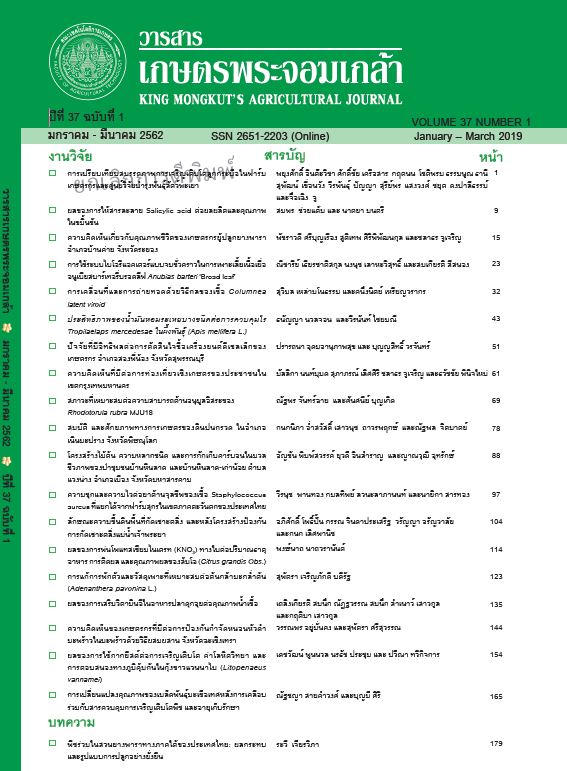การเปลี่ยนแปลงคุณภาพของเมล็ดพันธุ์มะเขือเทศ หลังการเคลือบร่วมกับสารควบคุมการเจริญเติบโตพืช และอายุเก็บรักษา
Main Article Content
บทคัดย่อ
มะเขือเทศเป็นพืชผักเศรษฐกิจที่ปลูกและบริโภคกันอย่างแพร่หลาย ทำให้ปริมาณความต้องการใช้เมล็ด
พันธุ์มะเขือเทศเพิ่มสูงขึ้นตามไปด้วย แต่เมล็ดพันธุ์มะเขือเทศที่ใช้บางส่วนมีความงอกและความแข็งแรงต่ำ
การให้สารควบคุมการเจริญเติบโตพืชแก่เมล็ดพันธุ์จะช่วยกระตุ้นการงอกและการเจริญเติบโตของต้นกล้าที่ดี
การทดลองนี้จึงมีวัตถุประสงค์เพื่อศึกษาผลของการเคลือบเมล็ดพันธุ์มะเขือเทศด้วยสารควบคุมการเจริญเติบโตพืช
จากนั้นติดตามการเปลี่ยนแปลงคุณภาพของเมล็ดพันธุ์และการเจริญเติบโตของต้นกล้าของเมล็ดมะเขือเทศหลังการ
เก็บรักษาในสภาพแวดล้อมที่แตกต่างกัน วางแผนการทดลองแบบ Completely Randomized Design (CRD)
จำนวน 4 ซ้ำ เตรียมสารเคลือบเมล็ดพันธุ์โดยใช้ Gum Arabic ที่ความเข้มข้น 3% เป็นพอลิเมอร์ ร่วมกับสารควบคุม
การเจริญเติบโตพืช 4 ชนิด ประกอบด้วย 9 กรรมวิธี ดังนี้ เมล็ดไม่เคลือบ (T1), เมล็ดเคลือบด้วยสารเคลือบเพียงอย่าง
เดียว (T2), เมล็ดเคลือบด้วยสารเคลือบผสม 2% GA3 (T3), 0.5% IAA (T4), 0.2% IBA (T5) และ 0.1% NAA (T6)
ตามลำดับ, เมล็ดเคลือบด้วยสารเคลือบผสม 2% GA3 + 0.5% IAA (T7), 2% GA3 + 0.2% IBA (T8) และ 2% GA3
+ 0.1% NAA (T9) ตามลำดับ หลังการตรวจสอบคุณภาพเมล็ดพันธุ์พบว่าการเคลือบเมล็ดด้วย 2% GA3 + 0.5% IAA
และ 2% GA3 + 0.2% IBA มีแนวโน้มทำให้ความยาวรากของต้นกล้ามะเขือเทศมากกว่าเมล็ดที่ไม่ได้เคลือบ
และการเคลือบเมล็ดด้วย 2% GA3 + 0.2% IBA ทำให้ความงอก ความเร็วในการงอก ความสูงต้น และความยาวราก
ของต้นกล้ามะเขือเทศดีมากกว่าการเคลือบเมล็ดด้วยวิธีการอื่นๆ หลังจากการเก็บรักษาในสภาพแวดล้อม
ที่แตกต่างกันเป็นระยะเวลา 6 เดือน
Article Details
วารสารเกษตรพระจอมเกล้า
References
43 (1)(พิเศษ). 260-267.
กิตติวรรณ กล้ารอด และบุญมี ศิริ. 2559(ก). อิทธิพลของการเคลือบเมล็ดด้วยฮอร์โมนพืชต่อคุณภาพเมล็ดพันธุ์และการเจริญเติบโตของ
ต้นกล้ามะเขือเทศ. วารสารเกษตรพระจอมเกล้า. 34(3): 143-156.
กิตติวรรณ กล้ารอด และบุญมี ศิริ. 2559ข. การเปลี่ยนแปลงคุณภาพเมล็ดพันธุ์มะเขือเทศหลังการเคลือบร่วมกับฮอร์โมนพืช. แก่นเกษตร.
44 (1)(พิเศษ). 339-344.
กิตติวรรณ กล้ารอด. 2559. ผลของการเคลือบเมล็ดพันธุ์ร่วมกับฮอร์โมนพืชต่อคุณภาพเมล็ดและอายุการเก็บรักษาของเมล็ดพันธุ์
มะเขือเทศ. วิทยานิพนธ์ปริญญาวิทยาศาสตร์มหาบัณฑิต. มหาวิทยาลัยขอนแก่น.
จิราภรณ์ หาญสุริย์ และบุญมี ศิริ. 2560. การเปรียบเทียบชนิดและอัตราของฮอร์โมนพืชที่ใช้เคลือบเมล็ดต่อคุณภาพเมล็ดพันธุ์แตงกวา
หลังการเร่งอายุ. แก่นเกษตร. 45(1)(พิเศษ). 307-313.
นาตยา มนตรี. กีรติ ข่อยแก้ว. สุกัญญา แสนภักดี และ อัญจนา จันทร์ปะทิว. 2557. ผลของออกซินต่อการงอกของเมล็ดและการพัฒนา
ของต้นกล้าหนอนตายหยากในสภาพปลอดเชื้อ. แก่นเกษตร. 42(3)(พิเศษ). 335-340.
บุญมี ศิริ มัสยา เอื้อประชา และวิทวัส ธีรธิติ. 2554. ผลของสูตรต?ำรับสารเคลือบที่แตกต่างกันต่อคุณภาพเมล็ดพันธุ์ข้าวโพดหวาน
ลูกผสม 3 พันธุ์. วารสารวิทยาศาสตร์เกษตร. 42(1)(พิเศษ): 477-480.
บุญมี ศิริ. 2558. การปรับปรุงสภาพและการยกระดับคุณภาพเมล็ดพันธุ์. ภาควิชาพืชศาสตร์และทรัพยากรการเกษตร คณะเกษตรศาสตร์
มหาวิทยาลัยขอนแก่น. 239.
ปรารถนา จันทร์ทา พัชราพรรณ คงเพชรศักดิ์ และสุกานดา ดอกสันเทียะ. ฮอร์โมนพืช (Plant Hormone). โครงการส่งเสริมการผลิตเอกสาร
ชุดการเรียนที่เป็นการสรุปเนื้อหาในรูปสื่ออิเล็กทรอนิกส์. 84.
พัชรา ลิมปนะเวช. 2554. การใช้สารควบคุมการเจริญเติบโตของพืชในการเกษตร. สืบค้นข้อมูลจาก http://www.phukhieo.ac.th.
ค้นเมื่อ 26 กรกฎาคม 2560
สมาคมการค้าเมล็ดพันธุ์ไทย. 2559. ปริมาณและมูลค่าการส่งออกเมล็ดพันธุ์ควบคุม ประจ?ำปี 2559. สืบค้นข้อมูลจากhttps://docs.
google.com/viewer?a=v&q=cache:3vH3atHySIgJ: www.thasta.com/pdf/2012. ค้นเมื่อ 28 กรกฎาคม 2560.
AOSA. 1983. Seed vigor testing handbook. Association of official Seed Analysis. Available:http: http://www.aosaseed.com/
seed_vigor_testing_handbook. Aug. 13, 2016.
Bakrim, A., M. Lamhamdi, F. Sayah and F. Chibi. 2007. Effects of plant hormones and 20-hydroxyecdysone on tomato
(Lycopersicum esculentum) seed germination and seedlings growth. African Journal of Biotechnology. 6(24):
2792-2802.
Chauhan J.S., Y.K. Tomar, N. Indrakumar Singh, Seema Ali and Debarati. 2009. Effect of growth hormones on seed
germination and seedling growth of black gram and horse gram. Journal of American Science. 5(5): 79-84.
Choi S.T., H.K. Ahn and Y.D. Chang, 1996. Effect of crude extracts and chopped shoot application of Allium spp. on rice
growth. Korean Journal of Crop Science. 41(6): 625-633.
Daoub, R.M., A.H., ElmubarakMisran, M., Hassan, E.A. and M.E., Osman. 2016. Characterization and functional properties
of some natural Acacia gums. Journal of the Saudi Society of Agricultural Sciences. In press.
Davies PJ. 1995. Plant hormones. Dordrecht: Kluwer Academic Publishers.
Davies, P.J.. 2010. Plant hormones: Biosynthesis, Signal Transduction, Action. Springer Dordrecht Heidelberg London New York.
Hentrich M., C. Böttcher, P. Düchting, Y. Cheng, Y. Zhao and O. Berkowitz. 2013. The jasmonic acid signaling pathway
is linked to auxin homeostasis through the modulation of YUCCA8 and YUCCA9 gene expression. Plant J. 74: 626-637.
Ikeda, A., EC. Gabazza, J. Morser, I. Imoto, M. Kuroda, CN. D’Alessandro-Gabazza, K. Hara, DB. Ruiz, PG. Bernabe,
M. Katsurahara, M. Toda, Y. Kobayashi, Y. Yano, Y. Sumida, K. Suzuki, O. Taguchi and Y. Takei. 2009. Presence
of thrombin-activatable fibrinolysis inhibitor in Helicobacter pylori-associated gastroduodenal disease. Helicobacter.
14(2): 147-155.
ISTA. 2013. International Rule for Seed Testing: Rules 2013. International Seed Testing Association. Zurich. Switzerland.
Jacob, S.R., M.A. Kumar, E. Varghese and S.N. Sinha. 2016. Hydrophilic polymer film coat as a micro-container of
individual seed facilitates safe storage of tomato seeds. Scientia horticulturae. 204: 116-122.
Liu, A., B. Wang and LA. Niswande. 2005. Mouse intraflagellar transport proteins regulate both the activator and repressor
functions of Gli transcription factors. Development. 132: 3103-3111.
Ljung, Karin, K. Hull Anna, Celenza John, Yamada Masashi, Estelle Mark, Normanly Jennifer, and Sandberga Göran. 2005.
Sites and regulation of auxin biosynthesis in Arabidopsis roots. Plant Cell. 17(4): 1090-1104.
Mohammad, M. and D.L. Smith. 2014. Plant hormones and seed germination. Environmental and Experimental Botany.
99: 110-121.
Petersson, S.V., A.I. Johansson, M. Kowalczyk, A. Makoveychuk, J.Y. Wang, T. Moritz, M. Grebe, P.N. Benfey, G. Sandberg
and K. Ljung. 2009. An auxin gradient and maximum in the Arabidopsis root apex shown by high-resolution
cell-specific analysis of IAA distribution and synthesis. Plant Cell, 21: 1659-1668.
Smalle J., M. Haegman, J. Kurepa, M. VanMontagu and D. VanderStraeten. 1997. Ethylene can stimulate Arabidopsis
hypocotyl elongation in the light. Proc Natl Acad Sci USA. 94: 2756-2761.
Taylor A.G. and G.E. Harman. 1990. Concepts and technologies of selected seed treatments. Annual Review
of Phytopathology.
Vandenbussche, Filip, H. Vriezen Willem, Smalle Jan, J.J. Laarhoven Lucas, J.M. Harren Frans and Van Der Straeten
Dominique. 2003. Ethylene and auxin control the Arabidopsis response to decreased light intensity. Plant Physiol.
133(2): 517-527.
Vanneste, S and J. Friml. 2009. Auxin: a trigger for change in plant development. Cell. 136(6): 1005-1016.
West, S.H., S.K. Loftin, M. What, C.D. Batich and C.L. Beatty. 1985. Polymer as moisture barrier to main seed quality.
Crop Science. 25: 941-944.
Woodward, AW and B. Bartel. 2005. Auxin: regulation, action, and interaction. Annals of Botany. 95(5): 707-735.
Yang Wen Qing. 2006. Effects of GA3, 6-BA and 2,4-D applied in cucumber seed film coating (Abstract). Available:
http://www.dissertationtopic.net/doc/1002130. Aug. 11, 2016
Yilmaz D.D. and A. Aksoy. 2007. Physiological effect of different environmental condition on the seed germination of Rumex
scutatus L (polygonaceae). Erciyes Üniversitesi Fen Bilimleri Enstitüsü Dergisi. 23(1-2): 24-29.

